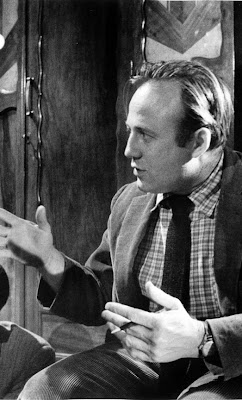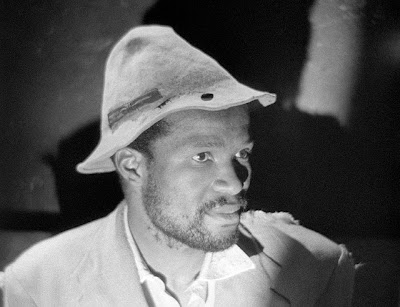Hot (well, warm) on the heels of its autumn 2010 re-release of Lionel's Rogosin's 1957 classic On the Bowery comes Milestone Films' re-release of Rogosin's follow-up COME BACK, AFRICA (made surreptitious-ly in darkest South Africa in 1959): a movie as odd and memorable in its way as was On the Bowery (a film that kept winning documentary awards -- although it was and is no documentary at all).
Come Back, Africa is even less like a doc than its predecessor, yet there, on the IMDB, in black and white, it is categorized as -- yup! -- a documentary. Instead it is a narrative movie about a relatively young black man living in South Africa during that country's dreadful near-half-century of apartheid. In it, Rogosin, shown at right, tracks the activities of this man (his name is Zacharia, and he is played somewhat haltingly but exceedingly believably, and with great humanity and warmth by Zacharia Mugabe -- shown below) in his first and only role as a performer.
Rogosin made his film on the sly, so to speak, fooling the South African powers-that-were into thinking that he was making, first, a travelogue for an airline company, then a movie about South African native music, and finally (to the delight of those in power) a film about the Boer War. But he did it. Despite incredible obstacles, the fellow got his film.
Before I go further, however, I need to make clear that, despite its being an amazing endeavor and coup, I don't think Come Back Africa is a terribly good film. Yet it is an important one as a social/political document and a project that shows what an engaged filmmaker can accomplish against great odds. No one else had attempted anything as bizarre and dangerous as this -- to show the world what life for Blacks under Apartheid was like -- but Rogosin had the courage and strength to try it, and succeed, even if the finished product is wanting.
What's wrong with Come Back, Africa? A lot. The story grows more melodramatic as it goes along, ending up in a frenzy that, as sad as it is, and as good a job as the leading actor manages, is still too heavy-handed by half. (Not that the events themselves are unbelievable, but as Rogosin shows them, they're just too much -- shown too quickly.)
The white (liberal, anti-apartheid) folk recruited to play nasty white South Africans are also not very good. But they're not actors, and so they overplay it. Again, not that real people weren't as obvious and unpleasant as we see here. But they were undoubtedly a lot more real, for the acting on-view tends to be one-note. The screenplay strains to encompass a wide swatch of Black life, but is almost always most effective when it simply shows rather than speaks. The street scenes of young musicians performing before a white audience (above) are clearly documentary and much more real than most of the "acted" situations.
There is one particularly interesting scene in which a group of Black men discuss everything from socialization to religion to the behavior of one of their own criminals. This scene has the sound of improvisation -- from men who know what they're talking about, and so it grabs you. The guys are joined eventually by Miriam Makeba who sings a terrific number that suddenly takes the movie into ultra-professional territory. As was the case with the documentary The Perfect Team, made by the filmmaker's son Michael Rogosin, and which told of the filming of On the Bowery, I believe you should not see the original Come Back Africa without also seeing the documentary (again made by the younger Rogosin), An American in Sophiatown (where much of the film was shot, and which the whites-in-power tore down soon after Rogosin's visit), which tells of the making of this difficult-to-film movie.
The excellent, 52-minute documentary fills in a lot of gaps and also allows us to understand why some of the film doesn't work all that well. As its fine Swiss co-cameraman, Emil Knebel explains, "Some sequences are weaker, but the spirit of the film is very strong." They are, and it is. But it is Ms Makeba, the single most professional person to appear before us -- whom we learn eventually rejected Rogosin's help and went off with Harry Belafonte; hell, even Marlon Brando got into this act) -- who puts the nail in the coffin of Rogosin's "art." She is said, according to a newspaper article of the time, to have called the filmmaker an "amateur." Once you've seen Come Back, Africa, you'll understand what she meant. Rogosin's work was necessary and important, and it is also amateur in many ways.
Come Back Africa -- black-and-white, 85 minutes -- returns to theaters after a 50-year absence (in order to celebrate the 100th anniversary of the African National Congress) in a beautiful new restoration by the Cineteca di Bologna, with the assistance of the Rogosin Heritage, with a one-week run at New York City's Film Forum, starting tomorrow, Friday, January 27 (you can order tickets for Film Forum here). If there will be other theatrical playdates prior to a DVD release (which I suspect and hope will include Michael Rogosin's documentary). The first of these will be in San Francisco, at the Roxie Theater, beginning February 3. More to come...
Thursday, January 26, 2012
Subscribe to:
Post Comments (Atom)









No comments:
Post a Comment